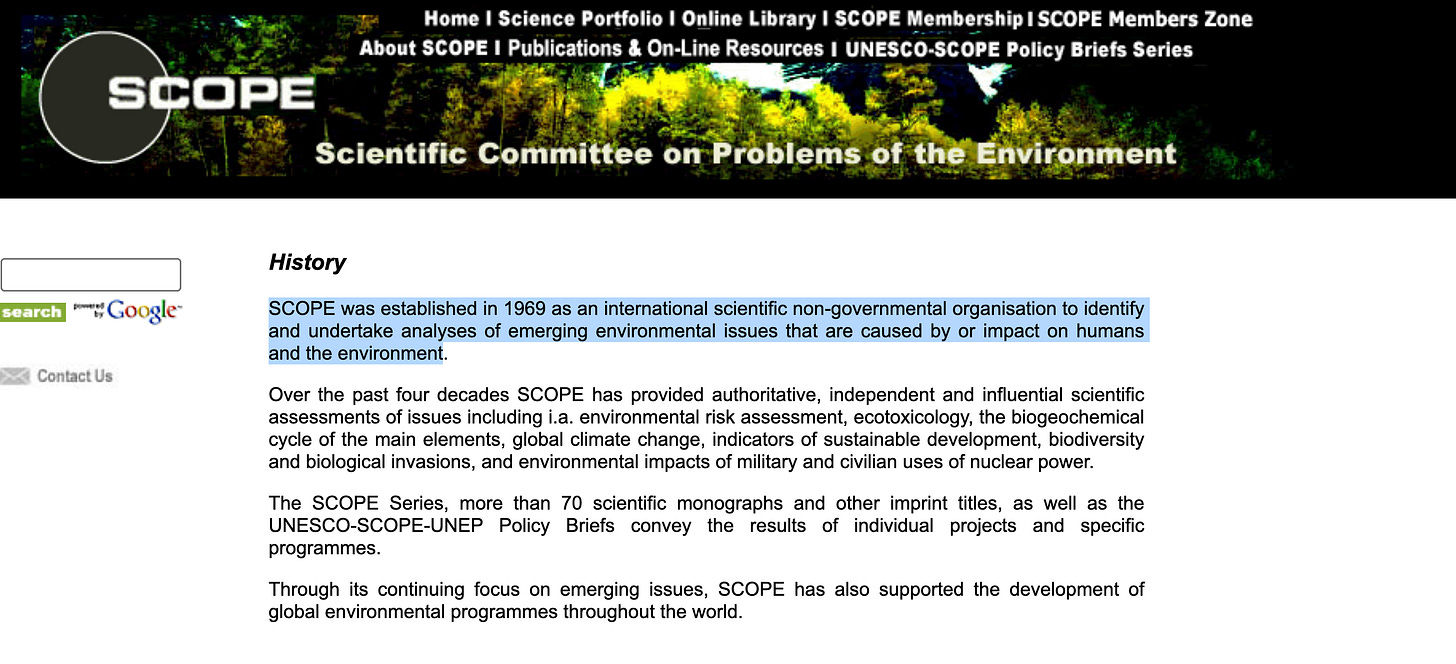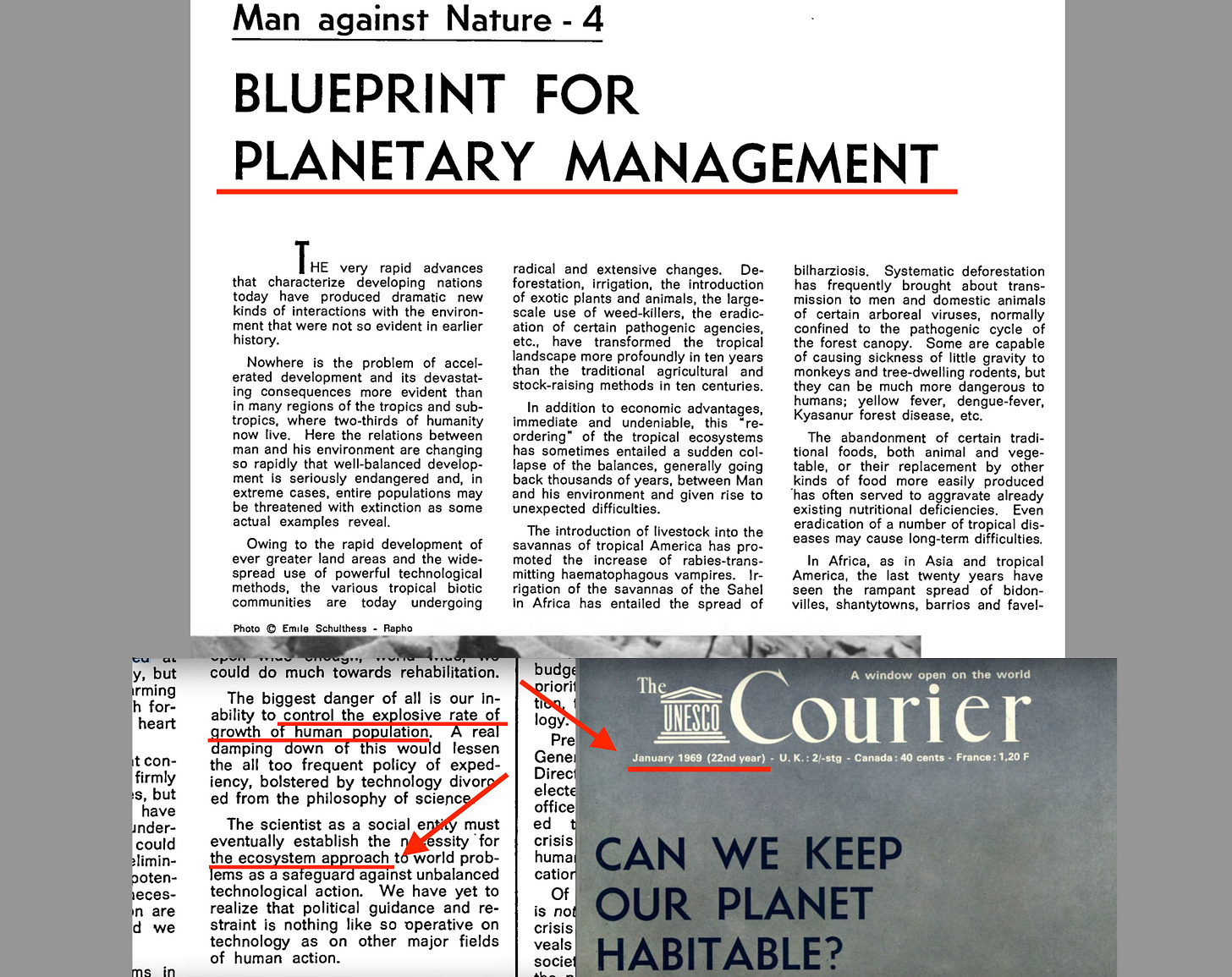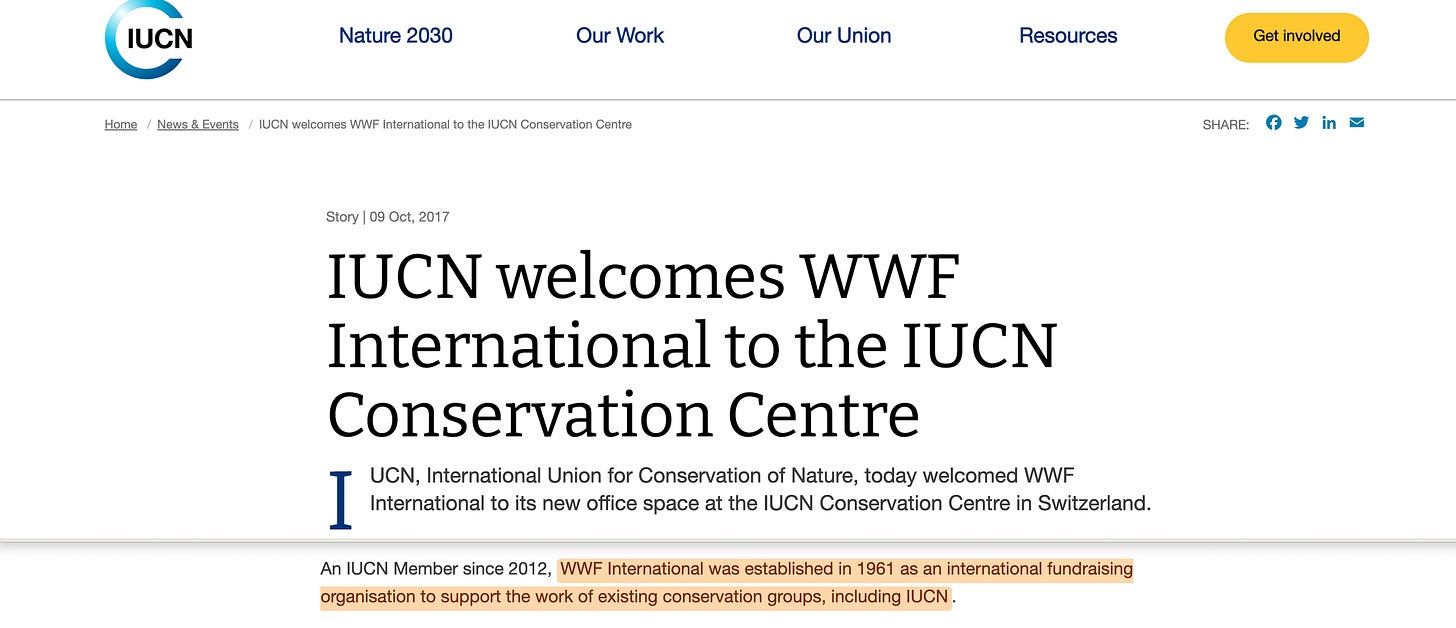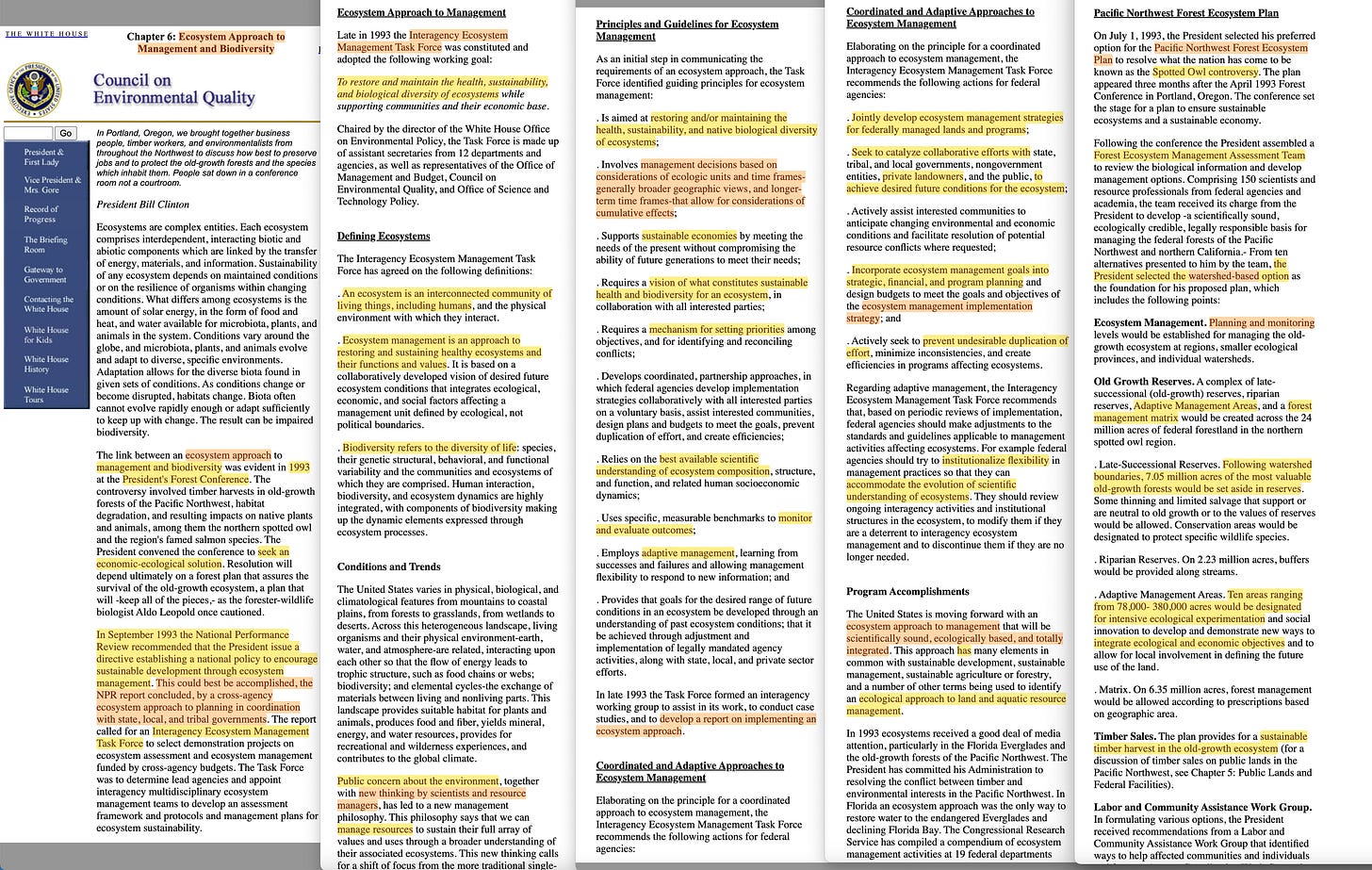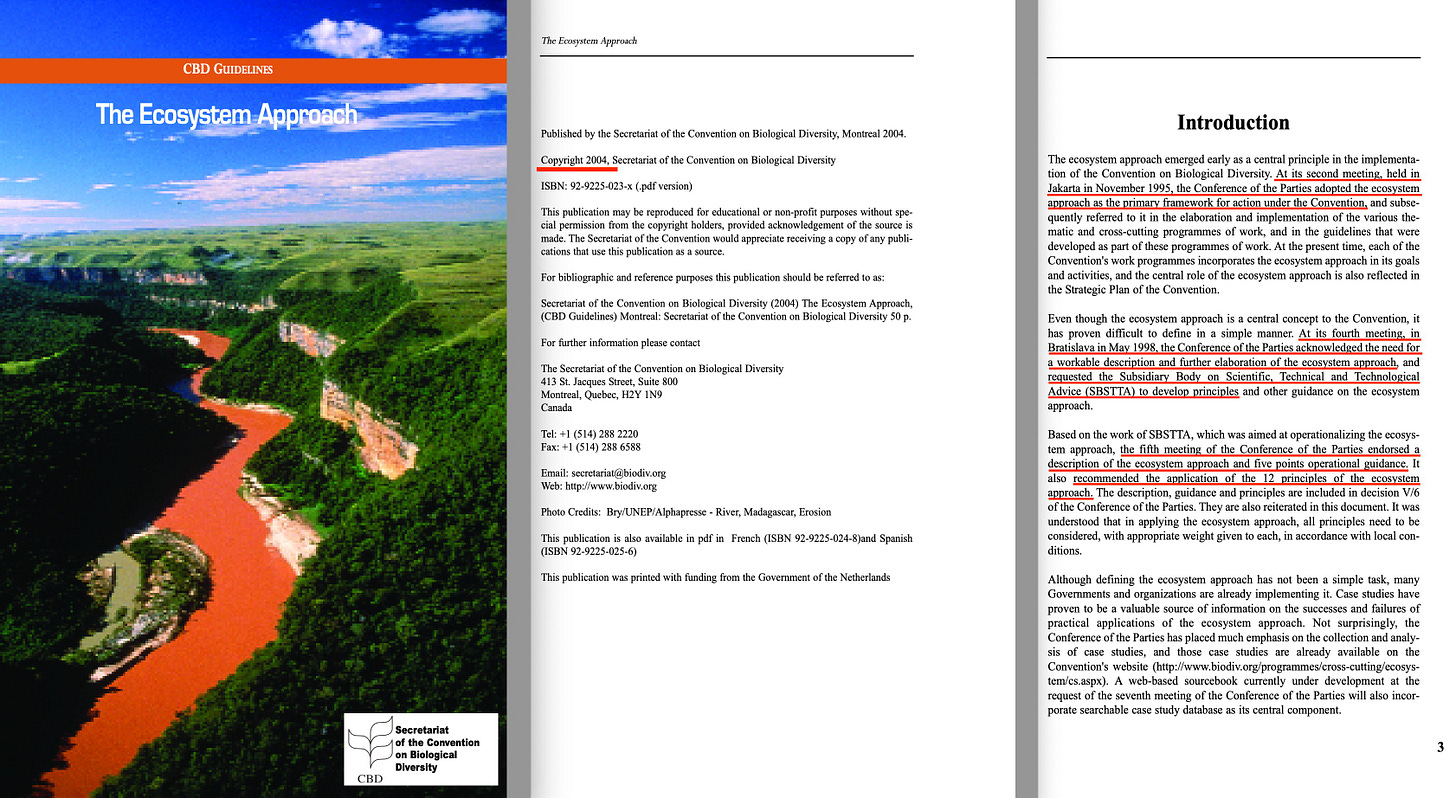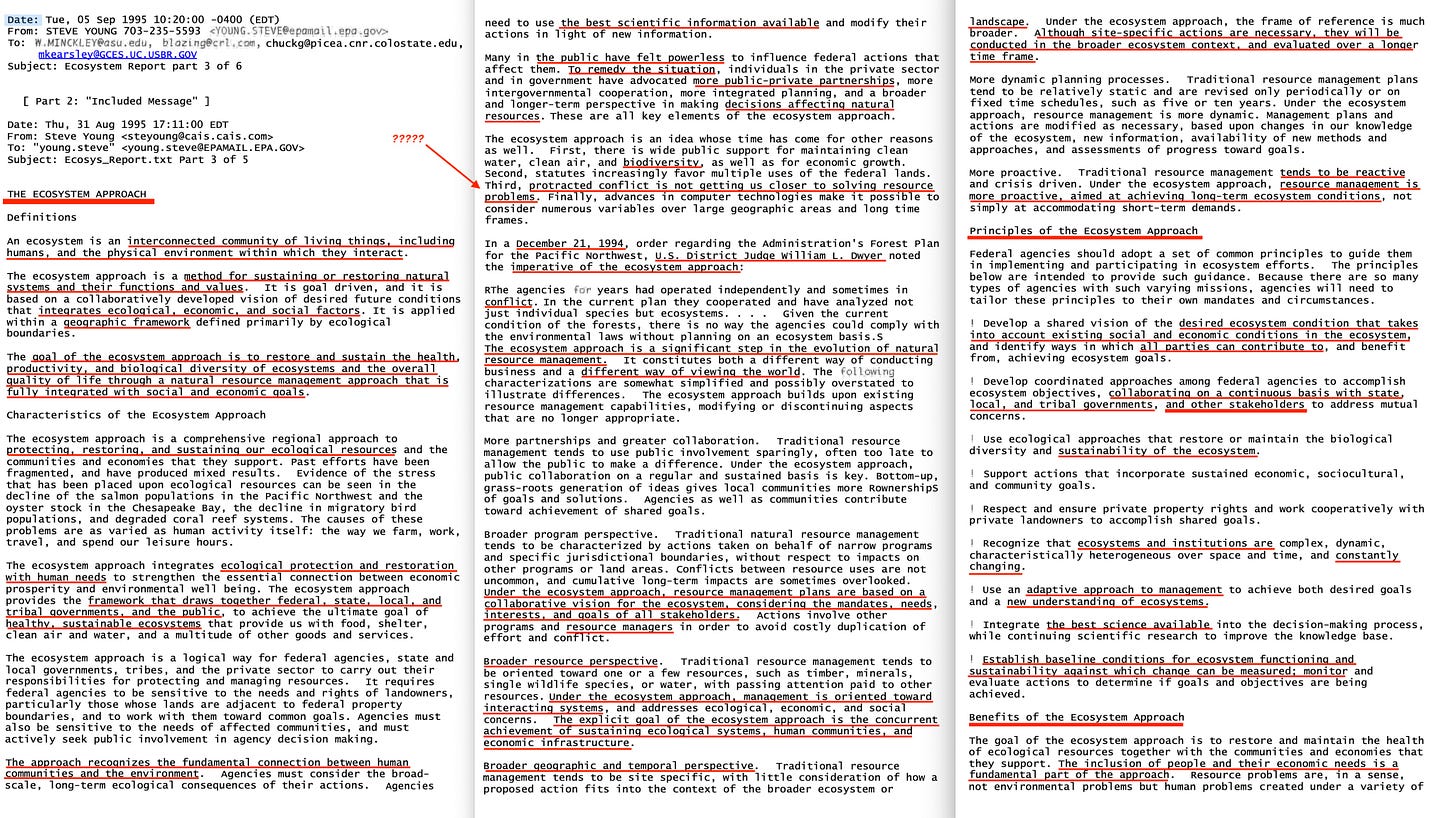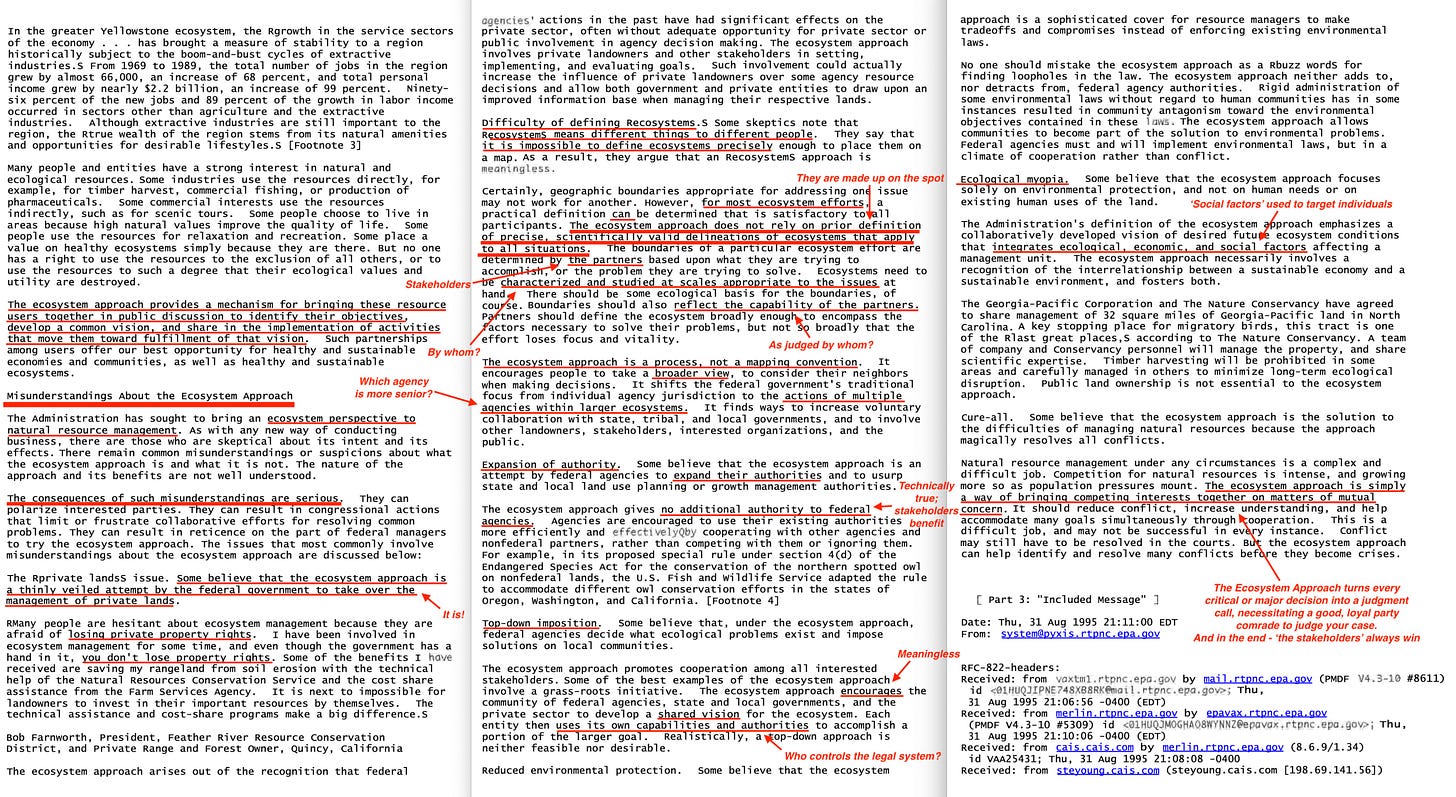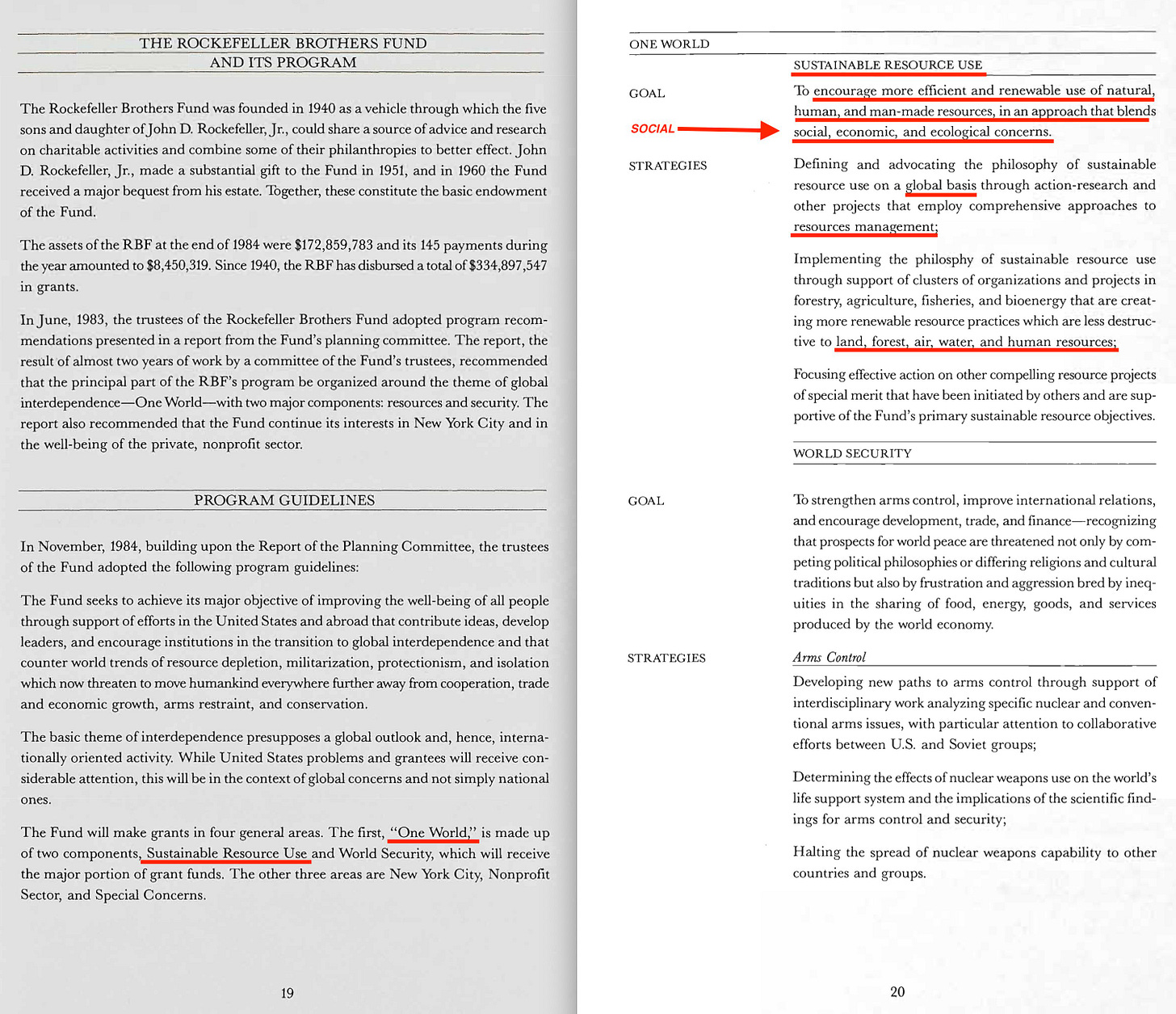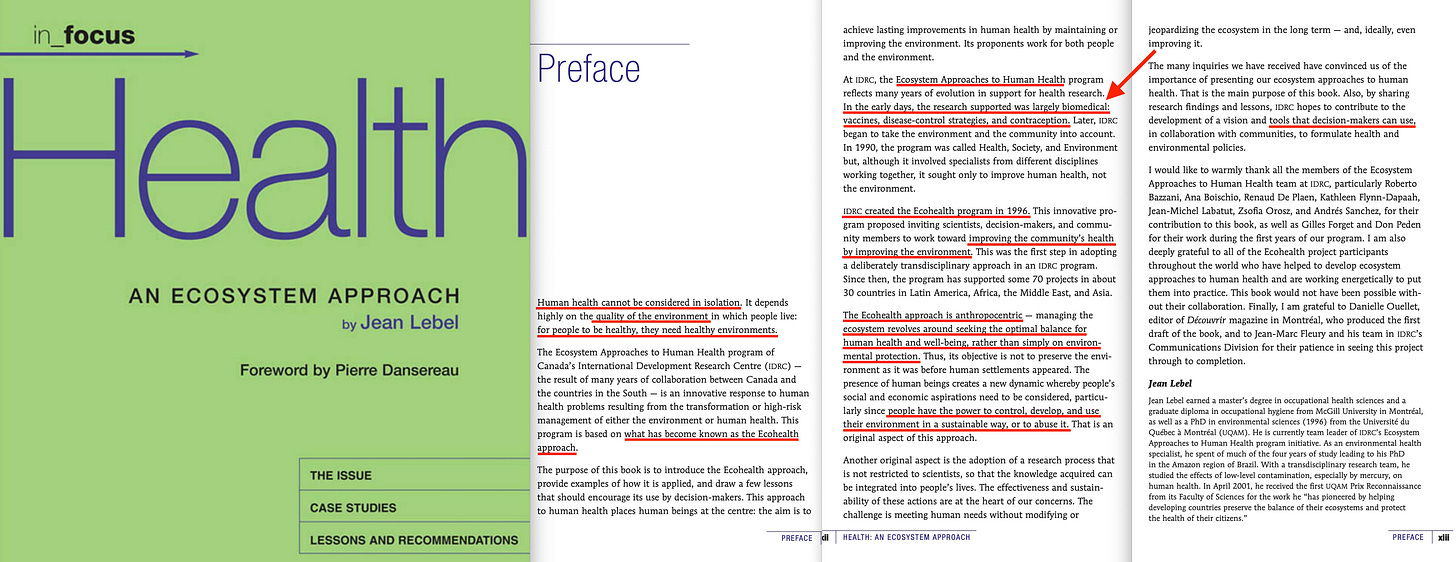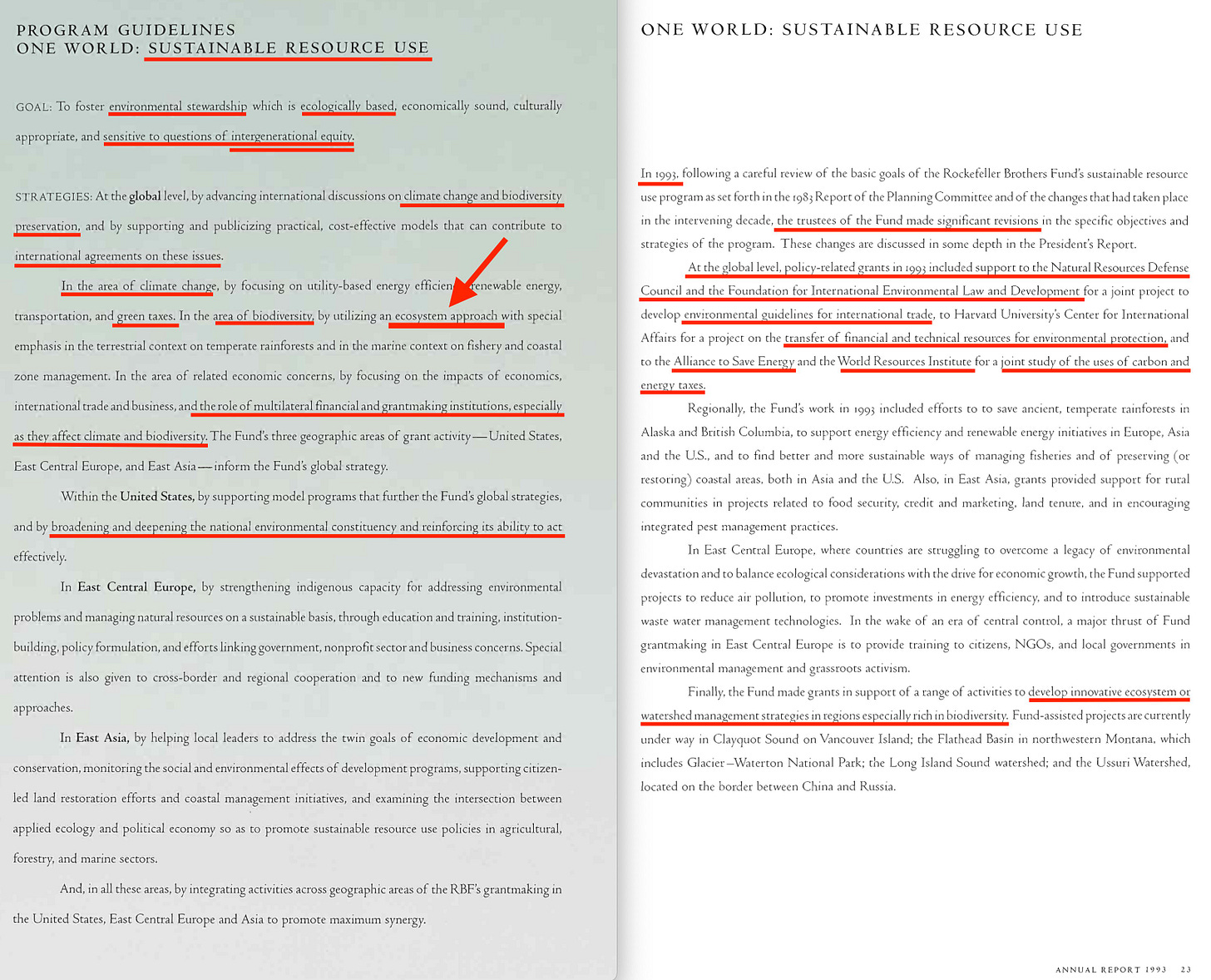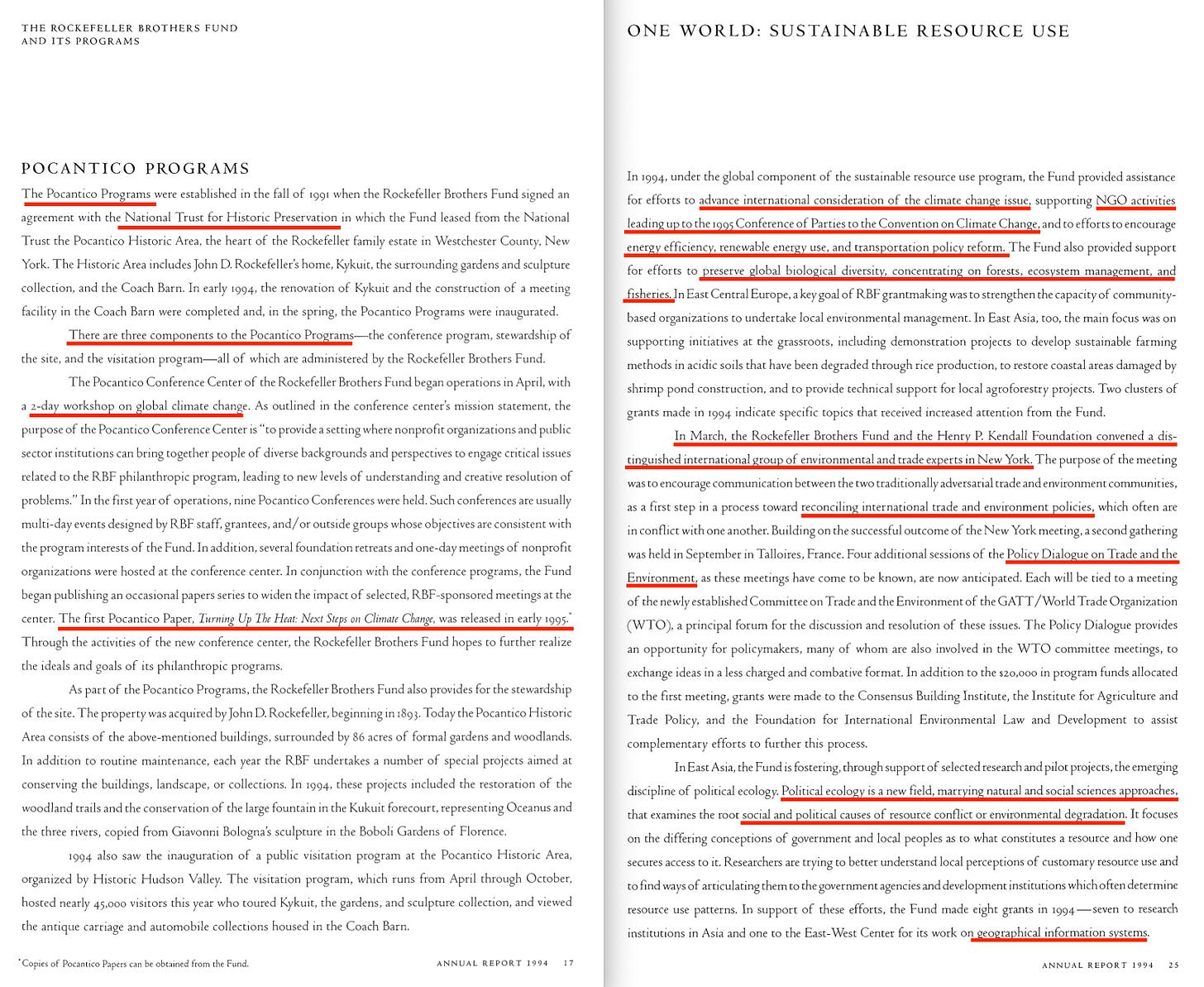Interagency Ecosystem Management Task Force
The National Environmental Policy Act of 1969 is the start of this particular story. Though the act itself was reasonably harmless compared to later initiatives, it opened a door several decades later. But let’s quickly go through the act itself.
Title One is about protecting and restoring the environment, about man in harmony with nature, about eliminating damage to the biosphere, about involving public and private institutions, and about striking a balance between population and resource use.
Yes, really. In fact, the focus on resource continues, declaring that the quality of renewable resources should be enhanced, and that the aim should be to attain maximum recycling of deplerable resources. And it follows, outlining how natural and social sciences should be integrated and used in all aspects which may impact man’s environment.
Before making detailed statements, Federal officials will need to consult with an agency with legal jurisdiction in any environmental health matter. And all such statements shall be forwarded to the President, as well as the to-be-established Council on Environmental Quality, which we shall return to in a minute.
All of which is interesting, because it establishes a hierarchy on information.
Recognition is furthermore called for in regards to worldwide and long-range environmental issues, and foreign policy should be constructed in a such way to foster international collaboration. And this, at the time of the Pearson report, which more-or-less demanded development aid in return for compliance. Oh, and did you know that Robert McNamara left the LBJ admin to take top seat at the World Bank at that time as well?
And finally, advice and information useful to the purpose should be made available. Again, somewhat of a hint of an information clearinghouse.
Title Two relates to the Council on Environmental Quality. It’s purpose is to create an annual Environmental Quality Report, which should detail the state of the environment, including… well… every aspect of it.
Further, the ‘adequacy of available natural resources… in the light of expected population pressure’ should be detailed, and a review carried out on all offices of authority, relating to policy impact on the environment, and the conservation thereof, and finally - the utilisation of natural resource.
The Council is further responsible for assisting and advicing the President, gathering timely and authoritative information, review Federal policies, conduct investigations, document and defines changes to the environment and accumulate data for continuing analysis, to recommend and develop national policies to the President in the pursuit of… well, that’s the thing, isn’t it. I’m supposed to say ‘environmental protection’, but frankly, with the benefit of hindsight, it somewhat appears other motives are at play.
Finally, the Council should consult with the Citizens’ Advisory Committee on Environmental Quality, which was established May 29, 1969 through EO 11472, and other organisations including representatives of science and conservation groups, and utilise information produced by public and private agencies and organisations, and individuals, including statistical data - which is probably expressly what those science and conservation groups will readily manufacture.
Now, remind me of a science group launching in 1969… oh yeah, here’s one. SCOPE. They wrote the early documents on GEMS, the Global Environmental Monitoring System, which passed in 1972 in Stockholm. And incidentally, their first report from 1971 was commissioned by… Maurice Strong.
‘SCOPE was established in 1969 as an international scientific non-governmental organisation to identify and undertake analyses of emerging environmental issues that are caused by or impact on humans and the environment‘
It’s just a little too coincidental, no?
As for conservation groups, here’s one. The IUCN. Incidentally, they partook in the 1968 UNESCO conference titled ‘Intergovernmental Conference of Experts on the Scientific Basis for Rational Use and Conservation of the Resources of the Biosphere‘, which led to this UNESCO Courier release from January, 1969. These two are interesting, especially as both refer to the ‘Ecosystem Approach’ - without actually defining what that is, nor where you can find a definition. The few loosely related remarks essentially go nowhere.
The 1969 document does however include the term ‘Planetary Management’. It wasn’t until WWF’s 2016 release of Codex Planetarius we discovered the second half of that sentence -
Incidentally, you do know the history of the WWF, right?
Regardless, the Council on Environmental Quality, in their 1993 Annual Report, recommended the creation of the ‘Interagency Ecosystem Management Task Force‘ with a stated mission ‘To restore and maintain the health, sustainability, and biological diversity of ecosystems while supporting communities and their economic base.‘
And here’s why that should raise an eyebrow -
The Convention on Biological Diversity, of course, launched in 1992 in Rio, but what’s of importance here is that at this stage, the CBD had not yet clearly defined that term.
‘The ecosystem approach emerged early as a central principle in the implementation of the Convention on Biological Diversity. At its second meeting, held in Jakarta in November 1995, the Conference of the Parties adopted the ecosystem approach as the primary framework for action under the Convention, and I quote -
‘Even though the ecosystem approach is a central concept to the Convention, it has proven difficult to define in a simple manner. At its fourth meeting, in Bratislava in May 1998, the Conference of the Parties acknowledged the need for a workable description and further elaboration of the ecosystem approach, and requested the Subsidiary Body on Scientific, Technical and Technological Advice (SBSTTA) to develop principles and other guidance on the ecosystem approach.‘
To me, this appears a remarkably aggressive push, given there’s no clear definition.
Now, in 1990 the Spotted Owl controversy kicked off, pitting environmentalists vs loggers and sawmill owners. On his election campaign trail, Clinton promised he would deal with the issue, and this led to a 1993 Forest Conference, and the Northwest Forest Plan of 1994.
And Clinton had just moved into the White House, when the conference was announced.
Clinton’s remarks from the 1993 Forest Conference can be located on YouTube, for the record, and what I find really interesting is that there suddenly is a ‘technical issue’ around the 2:50 mark, when he outlines his focus. Strangely convenient.
And let me quote the CEQ 1993 report here -
‘On July 1, 1993, the President selected his preferred option for the Pacific Northwest Forest Ecosystem Plan to resolve what the nation has come to be known as the Spotted Owl controversy. The plan appeared three months after the April 1993 Forest Conference in Portland, Oregon. The conference set the stage for a plan to ensure sustainable ecosystems and a sustainable economy.
Following the conference the President assembled a Forest Ecosystem Management Assessment Team to review the biological information and develop management options. Comprising 150 scientists and resource professionals from federal agencies and academia, the team received its charge from the President to develop -a scientifically sound, ecologically credible, legally responsible basis for managing the federal forests of the Pacific Northwest and northern California.- From ten alternatives presented to him by the team, the President selected the watershed-based option as the foundation for his proposed plan, …‘
The watershed-based option - aka the Watershed Protection Approach - outlines… well, more of the same. Protection and restoring of ecosystems, protection of human health, biological integrity, and so forth. But what’s more interesting is the description of what this approach entails -
Management units (the spatial element of the Landscape Approach), management cycles (the temporal element of the Landscape Approach), stakeholder involvement, strategic monitoring (surveillance), assessment (data analysis and visualisation), and so forth.
And as to why this should be implemented?
Because it brings ‘more direct focus by stakeholders’, allows ‘activities such as monitoring and permit writing’, ‘increased data sharing and pooling of resources’, ‘equitability’, and ‘innovative solutions such as ecological restoration, wetlands migration banking, and market-based solutions’, such as pollutant trading.
In other words, it’s not only a transfer of power, but it’s also a very early monetisation of what eventually became carbon and biodiversity offsetting.
And all in the name of 'stakeholders’ (ie, undemocratic), monitoring (surveillance), permit writing (control), ‘data sharing’ (centralised surveillance), and ‘equitability’ (enabling discrimination).
All all of this… partial Ecosystem Approach… as outlined by the EPA in 1995. There’s further an interesting document here, detailing the first 10 years.
And let’s take a closer look at the 5 principles announced by Clinton - ‘The Plan applies principles from conservation biology, ecological science, and forest science on a very large scale‘
Later in same document - ‘The Blue River Landscape Study in the Central Cascades AMA (Oregon) is testing a landscape management strategy based on a disturbance ecology approach‘
And I’m sure you can work out where I’m heading with this. Yeah, that’s the Landscape Approach.
However, back to the Task Force - in 1998, Elsevier released this paper; ‘Healthy ecosystems and sustainable economies: the federal interagency ecosystem management initiative‘ which outline more detail as to what said task force got up to -
‘A report prepared by about 20 agencies of the United States federal government provides answers, from a federal perspective, to these questions and more. Healthy Ecosystems and Sustainable Economies, the Federal Interagency Ecosystem Management Initiative contains three volumes:
Volume I: Summary and Overview, describes the ecosystem approach, identifies difficulties and successes and provides recommendations for improving implementation.
Volume II: Implementation Issues, contains more detailed findings and recommendations.
Volume III: Case Studies, contains case studies of seven regional ecosystems where federal agencies are working together and with nonfederal parties to implement an ecosystem approach.‘
And these were not trivial to track down. But they’re important. Because they contain more specific detail than any prior document I’ve tracked down.
Here’s volume 1, and here’s volume 2. If you have better versions, please comment below with link. It’s really only the first which is of interest here.
Let’s see that definition.
And let me be express - this was penned absolutely no later than 1995 - before the CBD settled on a definition.
First, we get the sales schpiel, it’s about protecting the environment, sustaining resources, yada yada. It’s a framework that draws the federal, state, local, and tribal governments together along with the public and it draws upon ‘the best available science’. So far, so good.
Now, let me quote -
‘Many in the public have felt powerless to influence federal actions that affect them. To remedy the situation, individuals in the private sector and in government have advocated more public-private partnerships, more intergovernmental cooperation, more integrated planning, and a broader and longer-term perspective in making decisions affecting natural resources. These are all key elements of the ecosystem approach.’
Hmm, yeah, doesn’t really sound like this will improve their feeling of powerlessness, but perhaps that’s just me. It continues -
’The ecosystem approach is an idea whose time has come for other reasons as well. First, there is wide public support for maintaining clean water, clean air, and biodiversity, as well as for economic growth. Second, statutes increasingly favor multiple uses of the federal lands. Third, protracted conflict is not getting us closer to solving resource problems. Finally, advances in computer technologies make it possible to consider numerous variables over large geographic areas and long time frames.‘
First off, the public support was drummed up through social scientist lies since 1969, biodiversity was a largely unknown concept at this stage, the conflict relates to the convenient 1990 Spotted Owl issue, and the advances in technology… does in fact allow for… global surveillance, which enables the long time frames and large geographic areas.
‘Under the ecosystem approach, resource management plans are based on a collaborative vision for the ecosystem, considering the mandates, needs, interests, and goals of all stakeholders. Actions involve other programs and resource managers in order to avoid costly duplication of effort and conflict.‘
Yeah, it’s a stakeholder economy alright.
‘Broader geographic and temporal perspective. Traditional resource management tends to be site specific, with little consideration of how a proposed action fits into the context of the broader ecosystem or landscape. Under the ecosystem approach, the frame of reference is much broader. Although site-specific actions are necessary, they will be conducted in the broader ecosystem context, and evaluated over a longer time frame.‘
This relates to the temporal component of the Landscape Approach. All centrally planned. All stakeholder.
‘Principles of the Ecosystem Approach... Develop coordinated approaches among federal agencies to accomplish ecosystem objectives, collaborating on a continuous basis with state, local, and tribal governments, and other stakeholders to address mutual concerns… ‘
As above. Coordinated stakeholder action.
‘Recognize that ecosystems and institutions are complex, dynamic, characteristically heterogeneous over space and time, and constantly changing… Use an adaptive approach to management to achieve both desired goals and a new understanding of ecosystems.‘
In short, they’re free to change direction as they see fit, as a consequence of…
‘Integrate the best science available into the decision-making process, while continuing scientific research to improve the knowledge base‘
… ‘the science changed’…
‘Establish baseline conditions for ecosystem functioning and sustainability against which change can be measured; monitor and evaluate actions to determine if goals and objectives are being achieved‘
… or the surveillance data rats you out.
Now, skipping down the text a bit -
‘The following discussion outlines some of the most important benefits... Consensus-building. Under the ecosystem approach, governmental decision-making processes are more open to the public, and the public is involved early in the process. Interested parties are encouraged to help establish goals and identify ways to achieve them.‘
But this, of course, depends upon the real stakeholders deciding that they need representation in the first place.
‘Certainty. Uncertainty about government programs, goals, and compliance requirements imposes a high cost on individuals and businesses. Uncertainty that continues into the latter stages of a project heightens conflict and polarization. To the extent that the ecosystem approach enables ecosystem issues to be addressed simultaneously or comprehensively, it offers major economic benefits to the private sector.‘
Unless ‘the science’ changes, of course. And sure, there won’t be any legal issue, because your rights as a property owner do not exist.
So up until now, we’ve more or less seen the very definition we use to this day. All key components are in there, and it’s all about the stakeholder for sure. But the best part is what comes next, in the ‘Misunderstandings About the Ecosystem Approach‘. I include it here, not because of the amusement value, but to give an example of how far ahead these people think -
‘The Administration has sought to bring an ecosystem perspective to natural resource management. As with any new way of conducting business, there are those who are skeptical about its intent and its effects. There remain common misunderstandings or suspicions about what the ecosystem approach is and what it is not.‘
‘The consequences of such misunderstandings are serious‘
OH NOES MISINFORMATION KILLS.
‘Some believe that the ecosystem approach is a thinly veiled attempt by the federal government to take over the management of private lands.‘
Which is… partially correct. Because it’s not the federal government, but the stakeholders.
‘Many people are hesitant about ecosystem management because they are afraid of losing private property rights. I have been involved in ecosystem management for some time, and even though the government has a hand in it, you don't lose property rights.‘
On this point, I still haven’t made up my mind. They technically don’t have to lose the lands themselves, because what’s at stage is the exploitation rights. But you lose property rights without the shadow of a doubt.
‘Difficulty of defining Recosystems. Some skeptics note that ecosystem means different things to different people. They say that it is impossible to define ecosystems precisely enough to place them on a map. As a result, they argue that an ecosystem approach is meaningless.‘
No, it is definitely not meaningless. It’s in fact this… lack of precision which is half the danger. Because the stakeholders could essentially tomorrow decide to convert your farmlands to a mine, in precisely the way you do playing Civilization. Because after all, that’s what those central planners who went along with clearly did.
‘The ecosystem approach does not rely on prior definition of precise, scientifically valid delineations of ecosystems that apply to all situations. The boundaries of a particular ecosystem effort are determined by the partners based upon what they are trying to accomplish, or the problem they are trying to solve. Ecosystems need to be characterized and studied at scales appropriate to the issues at hand… Boundaries should also reflect the capability of the partners.‘
And there’s the confirmation. The stakeholders - aka ‘partners’ in this text - can on a whim decide - on the back of the ‘science’ which ‘changed’ - that your farmland conversion is going ahead, starting tomorrow. And as for the capability - according to whom, exactly? Other scientists, appointed by those stakeholders, perchance?
I could go on here, but won’t. The point here is that their section, seeking to correct ‘misunderstandings’ is chock full of lies, and obviously scripted issues.
And we’ve seen that before, no?
So what this means is that we have a pretty damn close definition of what the Ecosystem Approach entails in a 1995 document, years before the Convention on Biological Diversity formalised theirs, which is - for all intents and purposes - identical. That begs the question. From where did it originate?
And there is one name you always find in this space. Rockefeller. More specifically, the Rockefeller Foundation. However, the Rockefellers also have a second, less well-known fund, titled the Rockefeller Brothers Fund. And going through their annuals give more than a hint as to a potential source.
The RBF launched their One World initiative in 1983, and in short, it’s about global interdependence, and its two components - resources and security.
But this is too early for specifics. The program has only just been launched.
So here’s the 1984 annual instead, and yes, theory gaining traction. Sustainable resource use include - ‘To encourage more efficient and renewable use of natural, human, and man-made resources, in an approach that blends social, economic, and ecological concerns.‘
There isn’t really any significant development, all the way up to 1990. All the reports essentially just cut-and-paste the above. But the 1990 edition markedly expands on the concept.
‘Goal: To encourage more efficient and renewable use of natural, human, and man-made resources, through an approach that blends social, economic, and ecological concerns.‘
Ah, there’s an approach. Good to know.
And you know what ‘social, economic, and ecological‘ sounds a bit like?
Like this 1990 outline - top-right - of the Ecosystem Approach. Sure, social is replaced with community, but then, a community is defined as a group of people who follow a social structure in a society. We are really, really close.
That document is from 2003, and can be located here. Yes, on the Convention on Biological Diversity’s website, but I’m sure that coincidental. And so is the title of the book. Oh, and its apparent focus on population sciences, which was a favourite topic of Rockefeller for decades? That, too, is a coincidence.
Back to the RBF Annuals, this one from 1993. Release before the above definition of Ecosystem Health per Al Gore’s Interagency Task Force.
Look at all those coincidences. We have intergenerational equity, climate change and biodiversity preservation, green taxes, and the Ecosystem Approach.
But wait - we’re not even done!
We also have ‘the role of multilateral financial and grantmaking institutions’, which sort of sounds like the providers of taxpayer money in relation to those blended finance deals.
And finally -
‘… the Fund made grants in support of a range of activities to develop innovative ecosystem or watershed management strategies in regions especially rich in biodiversity.‘
Oh wait - wasn’t that Clinton’s preferred strategy? GOLLY!
And the final one I’ll drag you through is this one from 1994.
We see a merger of trade and ecology, IPCCC meeting, a lot more climate change... and social sciences and 'geographical information systems' in East Asia.
Which would be convenient, as their main fund kicked off their global surveillance projects just a few years later, an initiative which launched the Mekon Basin Disease Surveillance initiative, and ultimately led to CORDS.
And, though I could continue, this is probably a good place to stop. I could easily continue, but this is long enough as it is.
On the establishment that it isn’t actually turtles all the way down, but Rockefeller.






